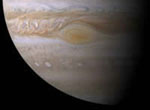News
SDSC Technology Enables UC Berkeley Professor to Predict Big Changes on a Big Planet
Published May 02, 2004
|
Nature Article NY Article |
Over the last 10 years, Marcus, a specialist in computational fluid dynamics has used the San Diego Supercomputer Center's (SDSC) Blue Horizon technology to develop complex 3-D computations that simulate Jupiter's chaotic weather systems. In the April 22, 2004 issue of Nature, Marcus forecasts that the big planet is nearing the end of a 70-year climate cycle and entering a period of global warming.
"I sort of grew up on SDSC technology. As a matter of fact, all of the calculations from this project - anything that involved moving electrons around on silicon- were performed using SDSC facilities," said Marcus. "I've been a user since about 1987 and I've kept utilizing SDSC because it gave me the best service and the most computing power."
Seeing spots
"This particular paper resulted when I realized that I had six or seven Ph.D. theses on computational fluid dynamics sitting on my shelf, and they were all hinting at more or less the same thing," explained Marcus. "The realization of how this research could explain what's happening on Jupiter was a real 'cartoon moment' - it was like a light bulb appeared above my head."
Marcus used whirlpools and eddies for comparison. His research is based on principles taught in junior-level fluid dynamics and on the observation that many of Jupiter's vortices are literally vanishing into thin air. For example in 1998, three large anticyclones known as the White Ovals became two White Ovals in 1998. Then two years later, the remaining two became one.
"What I found was that between every two anticyclones, there is one cyclone rotating in the opposite direction creating an incredibly stable configuration," said Marcus. "The computations generated at SDSC showed us that the cyclones eventually weaken and allow the anticyclones to merge and disappear - as the White Ovals did."
Marcus' computer simulation shows that anticyclones have cold centers and warmer perimeters. Ice crystals that form in the anticyclone's center swell up and move to the sides where they melt - creating the darker swirl surrounding a lighter colored circle that is visible from Earth. In contrast, the warm center and cooler perimeter of a cyclone creates the appearance of the filamentary clouds, which are less clearly defined and easy to miss when looking through a telescope.
Jupiter's Changing Climate
"I wouldn't be surprised if a third of Jupiter's spots in the southern hemisphere disappear in the next decade," said Marcus.
Why would the merger and disappearance of vortices affect the planet's temperature? Jupiter's relatively uniform temperature is due to the chaotic mixing of heat and airflow from these vortices.
"If you knock out an entire row of vortices, you stop all the mixing of heat at that latitude," says Marcus. "This creates a big wall and prevents the transport of heat from the equator to the poles."
As a result, the disappearing anticyclones reduce the mixture of air in Jupiter's atmosphere, causing temperatures to increase at the equator and cool at the poles by about 20 degrees Fahrenheit. According to Marcus' calculations, the increasing temperatures will destabilize the jet streams, making them more wavy.
"Eventually, the jet streams will become more turbulent. The waves will then break off, roll up into new vortices, beginning the climate cycle anew."
Marcus says the lesson of Jupiter's climate could be that small disturbances can cause global changes. Although, he cautions against applying the same model to Earth's climate, which is influenced by many different natural and manmade factors.
The Fate of the Great Red Spot
Luckily, fans of Jupiter's famed Great Red Spot won't need to worry - this storm will remain unaffected. Located in Jupiter's southern hemisphere, the spot's proximity to the equator saves it from destruction.
Spanning 12,500 miles, the Great Red Spot is twice the size of Earth. However, unlike Earth's storms and hurricanes, which are the result of low pressure systems and dissipate after days or weeks, the Great Red Spot is a high-pressure system that has been stable for more than 300 years and shows no signs of slowing.
About SDSC
The mission of the San Diego Supercomputer Center (SDSC) is to innovate, develop, and deploy technology to advance science. SDSC is involved in an extensive set of collaborations and activities at the intersection of technology and science whose purpose is to enable and facilitate the next generation of scientific advances. Founded in 1985 and primarily funded by the National Science Foundation (NSF), SDSC is an organized research unit of the University of California, San Diego. With a staff of more than 400 scientists, software developers, and support personnel, SDSC is an international leader in data management, grid computing, biosciences, geosciences, and visualization. For more information, see www.sdsc.edu.



